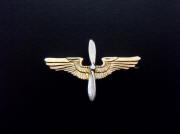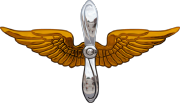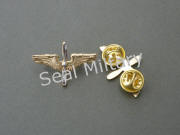|
This is the finishing
touch to any uniform ensemble. My own personal preference is for
original insignia, which is easily obtainable through ebay. This at
least adds a nice touch of authenticity when wearing reproduction
uniform. However, if budget restrictions dictate the purchase of
reproduction insignia, in my opinion the suppliers with the biggest
and best range of badges, patches and insignia are
Seal Military
and
Soldier Of Fortune.
If you are intending
to portray a USAAF officer, be aware that the winged propeller
branch-of-service insignia as worn on the lapels of the Class A jacket or shirt collar
should be of the correct pattern. Most suppliers advertising this
type of insignia are actually selling modern-day US Army Aviation
Branch badges which are not quite the same as the original USAAF
style. Below left is an original WW2-era USAAF lapel badge - notice
that the tops of the wings are fairly straight. In the centre is a
modern lapel badge of the US Army Aviation Branch - notice how the
wing-tips curl upwards and that the wings have a distinctly
different shape. This is the pattern incorrectly sold by most
suppliers as USAAF insignia. Below right is the pattern supplied by
Seal Military
which is very close to the original WW2 style of insignia, and is
the only one that I can currently recommend.



Seal Military stock far
and away the very best range of reproduction pilot's wings available in the UK, from standard metal
ones at very reasonable price to luxury sterling silver copies of Luxenberg's
that simply exude quality. Until 1942, it was the custom for USAAF
aircrew officers to wear miniature qualification wings above the
left breast pocket of their shirt when in Class B dress, but thereafter it became more common
for full-size wings to be worn. A good supplier I have found for miniature shirt wings is
USA Military Medals .
Click on the thumbnails at upper left for guides as to the correct
placement of badges and insignia. These images are taken from the
1943 edition of The Officer's Guide, a book published annually for
US Army officers.
Officer's rank insignia, aircrew wings
and medal ribbons are often available in two different forms:
pin-back (brooch-type) and clutch-back. The latter type have two or
more sharp pins that penetrate the uniform fabric and are secured at
the back with spring clips or 'clutches'. Although the pin-back type
can appear to be the easiest option to affix, they are actually
quite difficult to mount straightly. Clutch-back insignia are by far
the simplest type to make a neat job of mounting and are therefore
recommended. The only exception to this is in the case of
shoulder-mounted rank insignia: if the uniform to which the insignia
is to be affixed has 'open' shoulder loops (see my comments in the
Tunic section above) then clutch-back is the best and correct
option. If the shoulder loops are stitched closed then pin-back
insignia is the only option as the clutch-back pins will never
penetrate through all the layers of fabric on the shoulder to allow
the spring clutches to fit. See my note about insignia mounting pin
lengths in the Medal Ribbons section below.
Shoulder patches were sewn on the left arm only, centred on an
imaginary line from the shoulder seam to the cuff, the top of the
patch being 1/2 inch from the shoulder seam. The patch was usually
either the
winged-star Army Air Corps insignia or that of the Army Air
Force to which the officer was assigned. The most commonly-seen Air Corps
patches in England during WW2 were those of the
8th Air Force
whose aircraft carried out the strategic bombing of enemy targets in
Europe,
and those of the
9th Air Force whose aircraft attacked tactical
targets in Europe prior to D-Day and also provided paratroop transport and
glider tug aircraft for airborne operations. See images at left.
|


















